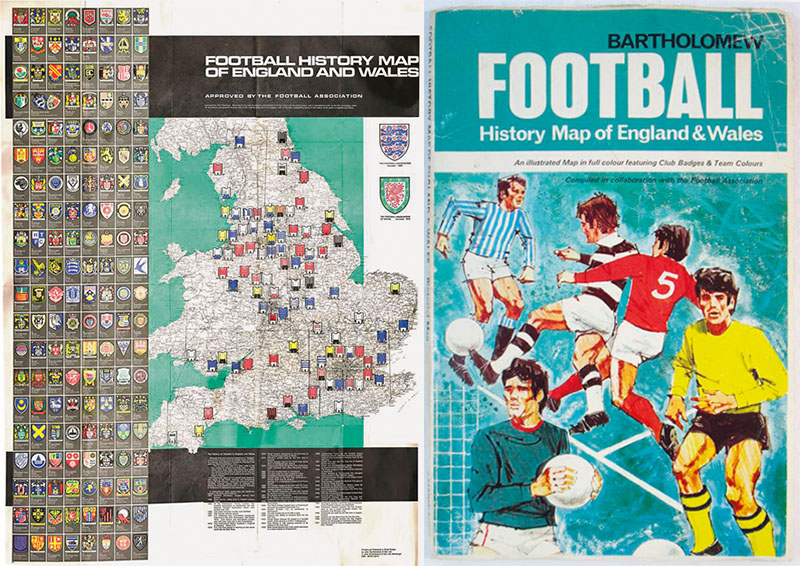
Having adorned countless bedroom walls across the country, the Bartholomew Football History Map still holds a fascination nearly 50 years after it was first published
6 May ~ Issued in 1971, the Bartholomew Football History Map of England and Wales is a work of art. It is foldable into A4 size but, unlike a road map where you only need the bit relevant to your journey, it needs to be framed or at least spread out as a whole to be properly appreciated.
On A0 paper (measuring 119 by 84 centimetres, its sheer size part of its magnificence) it provides a snapshot of what the Football League and higher echelons of non-League football were in 1971. The background consists of a faded map of England and Wales, containing relatively few motorways compared to today, on which are superimposed the kits of the 92 Football League members. The exact location of the relevant team is pinpointed via a line ended with a circle and cross-referenced to the club’s badge in the badge section. Coming from the days before satnavs and Google Maps, the exactness of this should be particularly appreciated. Unlike some of the more modern football maps, St Andrew’s, for example, is not just lumped in the general direction of Birmingham but placed precisely.
With the background a pale brown and white, the vibrancy of the kits shine through in their early 1970s simplicity with no thin stripes, mottled effects or stupid collars. The printing process nevertheless struggles to cope with more obscure colours. Blackpool’s tangerine looks a pale yellow and Wolves’ “old gold” a little suspect (though this in itself has been brighter and darker since the war). But Newport and Hull’s amber, York’s deeper red and the claret of West Ham and Burnley cope remarkably well.
The map itself demonstrates just by its political geography and completeness how the League evolved. We’ve probably all got an idea of this, but to see the concentrations on a map brings the point home. The north-west, Yorkshire and London are packed with teams all remarkably close together, exemplified in west London where a postage stamp could be placed over five clubs. The eye then catches the later expansion as outlying areas were filled in: Ipswich in 1938, Cambridge in 1970, Hereford in 1972 and Workington in 1951. Deserts still existed, such as across all of Wales (apart from the south) and most of the south of England that isn’t coastal.
The re-election process meant that there was little variation in the League’s membership from the 1890s until 1987 and the advent of regular relegation to what is now the National League. Barrow and Workington were still League members in the original version of the map. Later editions seem to have been updated rather hurriedly. My 1977 version shows new League members Wimbledon, who have just made it on with a map reference but no kit, while Wigan Athletic, who were to be elected in 1978, are not represented at all, even in badge form.
On the left-hand side of the map are 160 club badges representing, alongside the 92 League members, “all the leading clubs not in the league”. As if to emphasise this, the first eight are Aldershot, Altrincham, Andover, Anstey Nomads, Amersham Town, Arsenal, Aston Villa and Aveley, and the last Yorkshire Amateur. It should be noted that the club badges tell a story of lack of “progress” in its own right. Many are simply replicas of the town or city’s coat of arms (Brighton, Cardiff, both Bristols) while some bear no resemblance to their current badge (Bolton and Wolves). Those of both Manchester clubs are familiar 40 years later.
The bottom of the map is a potted history of important dates in the history of the game in England, and to the upper right the badges of the Football Associations of England and Wales confirm it is an officially endorsed product, adding weight to its importance.
The map now can only be found second-hand. Due to house moves and various rips, I’m currently on my third version (framed and on the wall for the first time – never let it be said that you are not wiser as you get older). Even more than 40 years since my father put it in front of me in 1977, it still holds a unique fascination. In the unlikely event that I ever get on Desert Island Discs, I know what object I’ll be taking. Mike Cochrane
This article first appeared in WSC 398, May 2020. Subscribers get free access to the complete WSC digital archive – you can find out more here
Tags: Object Lesson
